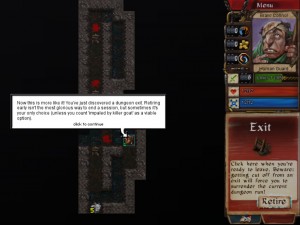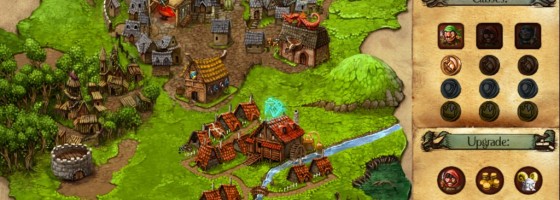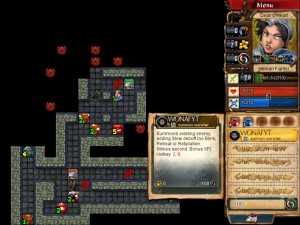Desktop Dungeons is the incredibly popular rogue-like/puzzle game that’s been out for a few years. With the recent update to it, I decided to finally see what the buzz is all about and there certainty is some interesting gameplay here. But the combination of genres leaves me scratching my head as to whether or not this is clever or just a frustrating game.
Puzzle-Like:
Desktop Dungeons’ story is pretty much about you trying to make a living in a fantasy world full of monsters, robbers and evil goats. After a brief tutorial you’ll be taken to the over world which represents the meta-game of unlocking new content but I’ll come back to that in a minute.
Quests involve you selecting a class and race to go into a procedurally generated dungeon and find and kill the boss. Every dungeon starts you out at level 1 with enemies of varying levels interspersed throughout the floor. The entire game is turn based as enemies won’t move or engage you normally unless you make the first move. The game is all about numbers as you’re given exactly how many hits it will take to kill an enemy and whether or not you’ll survive long enough to deal the damage.
The overall goal is to get to a high enough level that you can take on the boss and kill it to clear the dungeon; however it’s not that simple. There are never enough enemies in the level for you to get strong enough to kill the boss through simple progression of levels: IE you fight level 1 enemies until you’re level 2, fight level 2 until you’re 3 and so on. The trick is to figure out ways to kill enemies above your level or augment the experience gained to raise you up quicker and allow you to take on the boss.
This is where Desktop Dungeons gets interesting and the merging of the genres comes together. You can flee from any enemy to regain health and mana only when you are exploring new territory and the enemy will recover too. Die and you’ll lose everything in the dungeon but you can flee at anytime taking gold with you. The entire game is built on hard rules and systems designed for you to figure out how to subvert them to your advantage.
For instance, enemies that are slowed will not attack you first which can allow you to strike the finishing blow on a higher level enemy before he kills you.
Gear and magic runes can augment your strategies and figuring out the best combination is vital to beating the levels.
Gold is used for buying items during a level and back at the over world where the game features a brilliant use of meta-game progression and achievement screens to motivate you on.
Being the King:
The over world screen represents what you have unlocked and quests available to explore. As you play through the game, you’ll be able to upgrade your town to get new classes, bonuses in the dungeons and basically advance through the game. The game teases a lot of content and challenges for you to go after — Class specific quests, puzzle levels, new races and so on. All the while your kingdom will grow to include more buildings and fill up the map.
This kind of meta-game progression was a smart move by the developers as it allows someone to continue making some progress even if they get stuck on hard quests. The game has a lot of different challenges beyond just completing the quest. Many areas will reward you for beating them with different classes, badges can be earned for fulfilling specific conditions and new enemies and situations can appear in the procedurally generated levels.
Even though the game is unique and challenging, it definitely falls on the side of frustration a number of times.
Deadly Puzzles:
The issue that I have with Desktop Dungeon was how the game was designed as a puzzle game with rogue-like elements and not a rogue-like with puzzle elements and yes there is a difference between the two.
A rogue-like with puzzle elements is where the player must figure out the best ways through but can still influence their choice with certain decisions, Crypt of the Necrodancer and possibly Spelunky are examples of this. Desktop Dungeons is a puzzle game and is more about the player figuring out the trick of the quest as opposed to influencing the outcomes through direct play.

There is a lot humor in the game’s messages which is important as you’re going to be dying a lot and could use a laugh
It can feel like some quests are all about trial and error as one wrong enemy kill, use of a skill/item or moving can screw you up.
Because you only regain health and mana via exploring new territory, there are a finite number of times you can recover in a single stage.
The puzzle-like nature of the game also extends into the learning curve as the game leave it up to you to figure out the rules and systems in play. For a game about numbers, I felt like there was some information missing like augmenting damage from special sources, damage mitigation and some of the math from a quick look didn’t make sense to me.
Doing some of the game’s actual puzzle levels, there were times where I beat them yet I had no idea what I did differently that time compared to those that came before. A lot of the game’s more subtle mechanics and rules are found on icons in the UI and it can be difficult to parse out their meaning and functionality. While the puzzles are meant to be extended tutorials, I felt like every new mechanic or explanation could use one more signpost as the game leaves things half explained.
This is the problem that you run into with any puzzle game that deals with abstraction: That it’s incredibly hard to learn the rules and how things work as you can’t easily see the mechanics at play. I previously compared this kind of learning in Spacechem vs. Infinifactory and how the later was easier for me to learn as everything was laid out in front of you and you could do things step by step.
Head Scratching Difficulty:
Desktop Dungeon is a game that I can’t help but admire its design while feeling very frustrated with it. This is a puzzle game where the solution is constantly changing which is good and bad. There is enough variability thanks to the procedurally generated levels that you can play this for a very long time, just keep in mind that is an intentionally frustrating experience.
I already put together a video talking about the game more, but if you want to see more videos, leave a comment and maybe I’ll make this one of my daily games.


